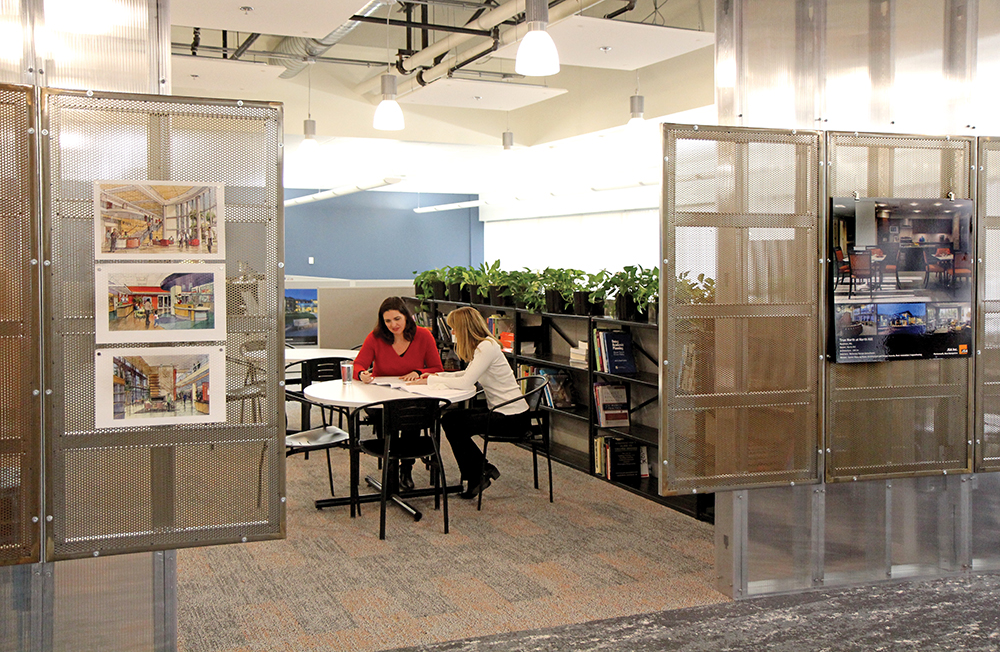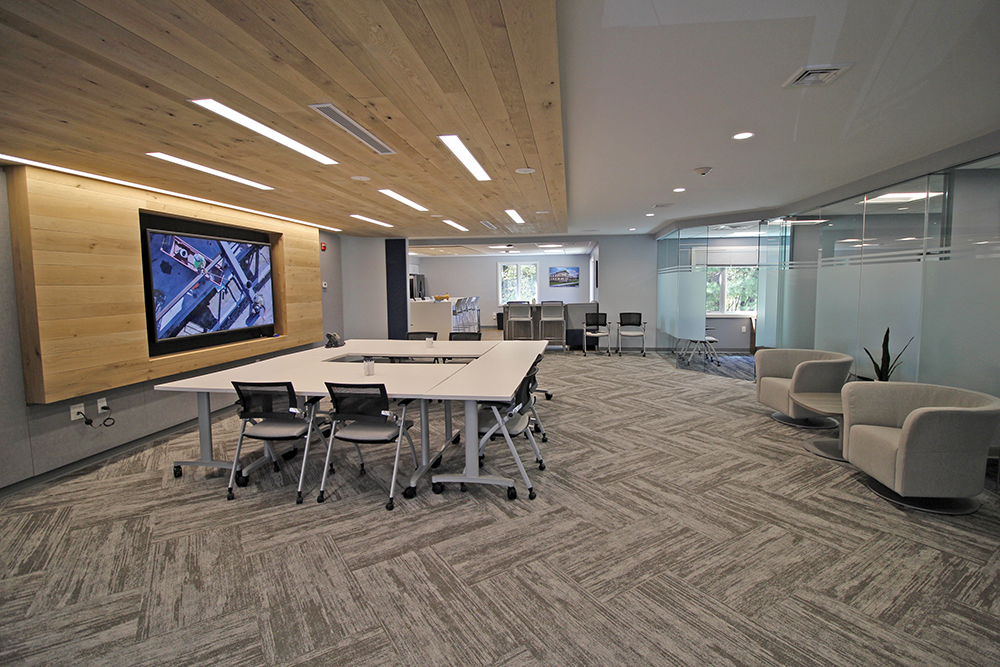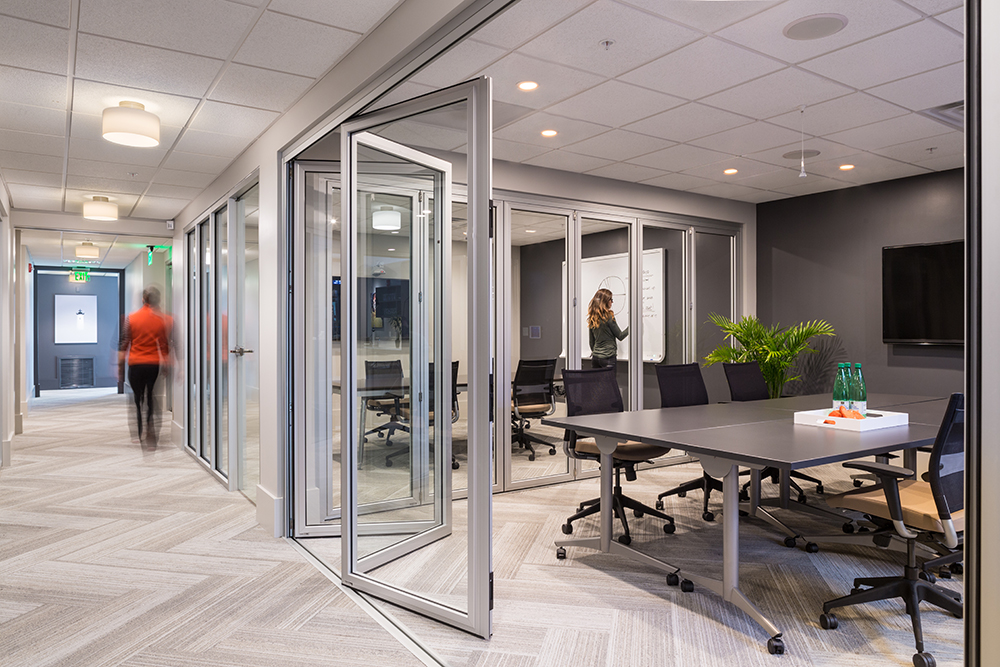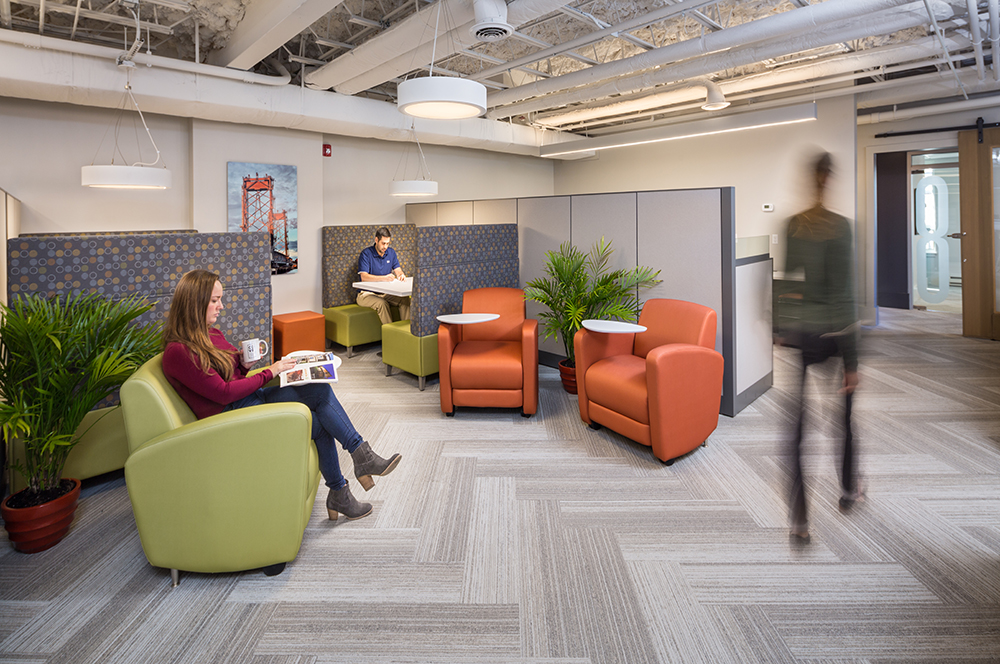 Team members use a collaborative work space at JSA in Portsmouth. Courtesy photo.
Team members use a collaborative work space at JSA in Portsmouth. Courtesy photo.
It seems businesses are tearing down walls rather than building them as the open office trend has become an ingrained part of corporate culture. Instead of separating employees into cubicles or offices, companies are creating more open and transparent work settings.
This spring, JSA, a Portsmouth architecture firm, moved to newly refurbished offices at Pease Tradeport and used its expertise to create a space aimed at fostering greater collaboration among staff as well as a healthier work environment. “We are a little more collaborative and open. Our walls are coming down,” says Anne Weidman, the firm’s business development and community outreach director. She notes the firm now has more collaborative work spaces, a more casual conference area, and soft seating.
These changes are not only meant to benefit their existing staff, but also help JSA attract millennials who want such a work environment. Sandra Hodge, head of the interior design studio at JSA, worked on the new office space, which groups teams together to encourage teamwork. “There is common space with a large stand-up table where people can bring drawings out,” she says. “There are also soft spaces for more casual meetings.”
From tech firms to libraries, the move to more open spaces is evident. “We are seeing a lot of glass and certainly seeing a lot of collaboration-type spaces with a large flat-screen panel on a wall connected to a PC that allow people to sit around and talk to each other about what is shown [on the screen],” says Preston Hunter, vice president of Eckman Construction in Bedford.

Eckman Construction's office includes an open space that can be configured for large or smaller meetings. Courtesy photo.
The end result—whether it is in academia, the nonprofit sector or the private sector—is that “Individuals are rarely siloed in their work spaces, and the expectation is that people will work with others on their projects,” Hunter says.
Jennifer Ramsey, owner of SOMMA Studios in Portsmouth, has helped many companies reinvent their office spaces or create new ones, and says by removing physical barriers, companies are also tearing down traditional business models.
“The focus on office design is often about transparency, literally and figuratively. Again, the separation and hierarchy of colleagues in a space is less defined by the ‘corner office.’ Coworkers in varying positions share more common space and have visibility of each other,” she explains.
There is also a more practical reason for having fewer walls—it brings in more light. Ramsey says including natural light in renovated office spaces is a high priority for companies. “In parts of the Seacoast, we are often converting older space for these new uses. We have to be aware of what every new wall does to the light quality. We have to carefully assess when a room is deserving of privacy or concealment. The trend leads toward working more with glass and furnishings that organically begin to create space,”she says.
There are conversations that require privacy, though, and designers are finding solutions beyond a conference room to accommodate those. Ramsey designed COVE Workspace, a coworking space in Portsmouth that provides a variety of work spaces for rent, from an open co-work space to small private offices. To help address privacy issues, COVE includes phone booths and small, two-person breakout spaces, she says.

COVE Workspace in Portsmouth offers a variety of work spaces (above and below) . Courtesy photos.

And that setup is attracting small businesses and entrepreneurs because it allows interaction with other professionals. “We are in an era when it’s not just young people with laptops and earpieces vying for seats. We have all age groups launching here, and it’s fun to see a collision of these generations hanging out and engaging in conversation, sharing ideas,” she says. “COVE has been operational for nearly four years, and in that time we have expanded and evolved the space twice and are discussing future expansion due to popularity.”
Flexibility Is Key
Hunter says technology is changing the way people interact with their work spaces and reshaping the types of spaces businesses want. “We are finding that more office spaces are looking to have laptops instead of fixed stations. That enables workers to be more flexible with where they are doing their work,” he says.
Nico Flannery Pitcher, a senior interior designer and senior associate of Lavallee Brensinger Architects in Manchester, agrees office space trends are driven by technology.
“I am working with a client in Concord. We are in the process of reviewing their existing 25-year-old work space and looking to bring in and modernize with the current workplace trends,” Pitcher says. “They have a lot of staff now who work remotely, so creating better space for drop-in spaces, when their staff comes in from the road, will give them better utilization of space.”
She also finds ways to deal with the privacy challenge in an open concept. Her client wants casual meeting areas and activity-based work zones, so if someone needs to get up and talk with a colleague, they can go to an area where they will not disturb other staff members, Pitcher says.
The client is looking to provide better access to daylight and a more comfortable work environment that accommodates different work styles, including privacy when needed.
Instead of the one-size-fits-all solution, Pitcher says people are looking for a work environment that has some social leanings with an emphasis on wellness options, acoustic privacy, access to daylight, café spaces and lounge spaces.
Quality of Life
More businesses are seeking work spaces that address quality of life, Ramsey says, such as built-in day care, exercise space and recreation amenities. Companies also care about having healthy food options located nearby or inside the same building.
“We are a workforce who knows what we should be doing for a more balanced life, so the more attainable you can make that, the better,” Ramsey says.

 Current Issue - April 2024
Current Issue - April 2024